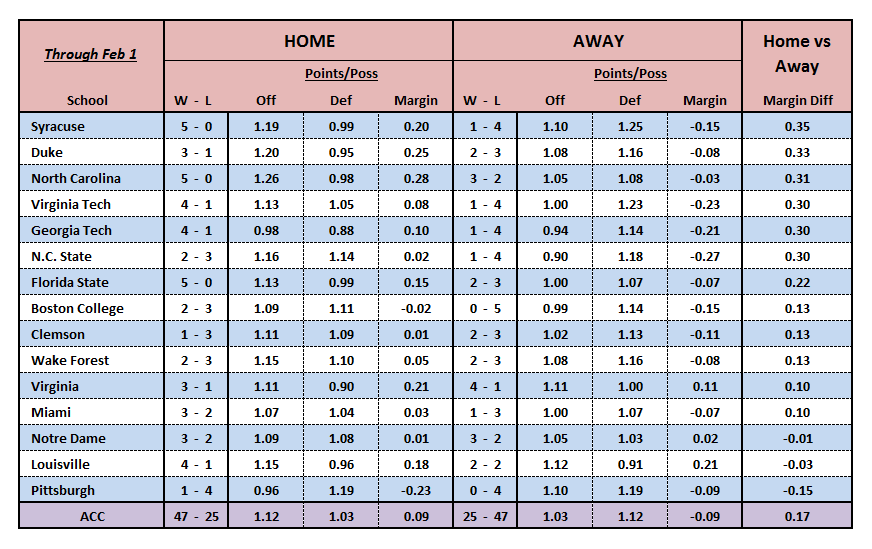Inside the ACC Numbers: Volume III
Posted by Brad Jenkins (@bradjenk) on February 3rd, 2017Here is the latest edition of our weekly review of the current ACC standings and team performances, where we focus on which teams are playing better or worse than their records indicate. Each week we delve into advanced metrics to reveal a few interesting teams, player statistics and trends. We are at the halfway point of conference play, so we now have more data points to look at – numbers which reveal some interesting trends. This week we will look at home versus away results for each team in the league so far this year. Finally, we forecast how the final ACC standings may look given current efficiency margins, and what that means for teams’ postseason aspirations.
Note: All data is current for games played through Wednesday, February 1.
Current Standings

Despite suffering some recent injuries to its backcourt, Louisville looks like the ACC’s best squad at the halfway point in conference action. The Cardinals’ efficiency numbers are certainly boosted by the 55-point shellacking that they put on Pittsburgh, but remember that North Carolina and Duke also put together dominant one-game performances against NC State and Georgia Tech, respectively – and they have played softer league schedules to date. Further down the standings we see some teams with records that do not correspond with their per possession performance. For instance, Virginia Tech may be 5-5 in the ACC standings but its overall play from an efficiency standpoint has only been slightly better than that of Boston College (against comparable schedules). Keep on eye on Clemson – the 3-6 Tigers have now won two in a row and four of their losses have come by five points or fewer or in overtime. North Carolina may have faced the league’s easiest slate so far, but that’s about to change. The Tar Heels have only faced two ACC foes with winning records so far, but their last eight contests will feature six such squads.
Advanced Statistic of the Week: ACC Home vs. Away Performance

Last month (in two parts: here and here), we wrote about home court advantage in the ACC. In that piece we noted that, after two years of ACC home court winning percentage hovering around 57 percent in conference games, home teams ramped up to 65.9 percent last season. It looks like that trend is continuing – home squads in conference play this season have been victorious 65.3 percent of the time. For better context, that league-wide margin of 0.09 points per possession noted above equates to a home court edge of almost six points per game.
A few things stand out. First, six teams — Syracuse, Duke, North Carolina, Virginia Tech, Georgia Tech and NC State — have an efficiency margin of 0.30 or better at home, which means that those squads perform about 20 points better at home than when they travel. For example, ACC teams are having no luck stopping North Carolina’s offense in Chapel Hill, but the Tar Heels turn out to be merely an average scoring team on the road. Georgia Tech can trace its surprisingly effective play in conference games to the league’s top defense on its home court — the Yellow Jackets are clearly not the same defensive team in other arenas. And speaking of defense, Virginia and Louisville are proving the old adage that good defense travels well. The Cavaliers and Cardinals are the only two teams in the league with a road efficiency margin of more than 0.10. Notre Dame has been the most consistent team with respect to venue, as the Irish post slight margin advantages both at home and on the road.
Future Forecast

The above table shows predicted order of finish with final regular season records based on KenPom’s current win probabilities for each team. Also included are a few comparative rankings that are mentioned frequently when evaluating NCAA Tournament potential, as well as projections from two bracketology experts — ESPN‘s Joe Lunardi and CBS Sports‘ Jerry Palm. Note that while they project the field as if it were named tomorrow, we make our projections based on the final KenPom projected records.
For the first time this season, Lunardi and Palm agree on which 10 ACC teams should currently be in the field. In our projection we replace Miami with Wake Forest. We feel that the Deacons’ strong strength of schedule will trump a Miami team that may finish one spot ahead of them in the final standings. Many pundits are saying that any team that finishes with a .500 mark in ACC play this year will get a bid. We think that is true for all but Syracuse – even if the Orange get nine conference victories they are still likely to have 15 total losses (including ACC Tournament action). No school has ever received an at-large bid to the Big Dance with more than 14 defeats on its ledger, and with a mediocre non-conference strength of schedule (RPI – #152) Jim Boeheim‘s team would not be a good candidate to break that tradition.










































